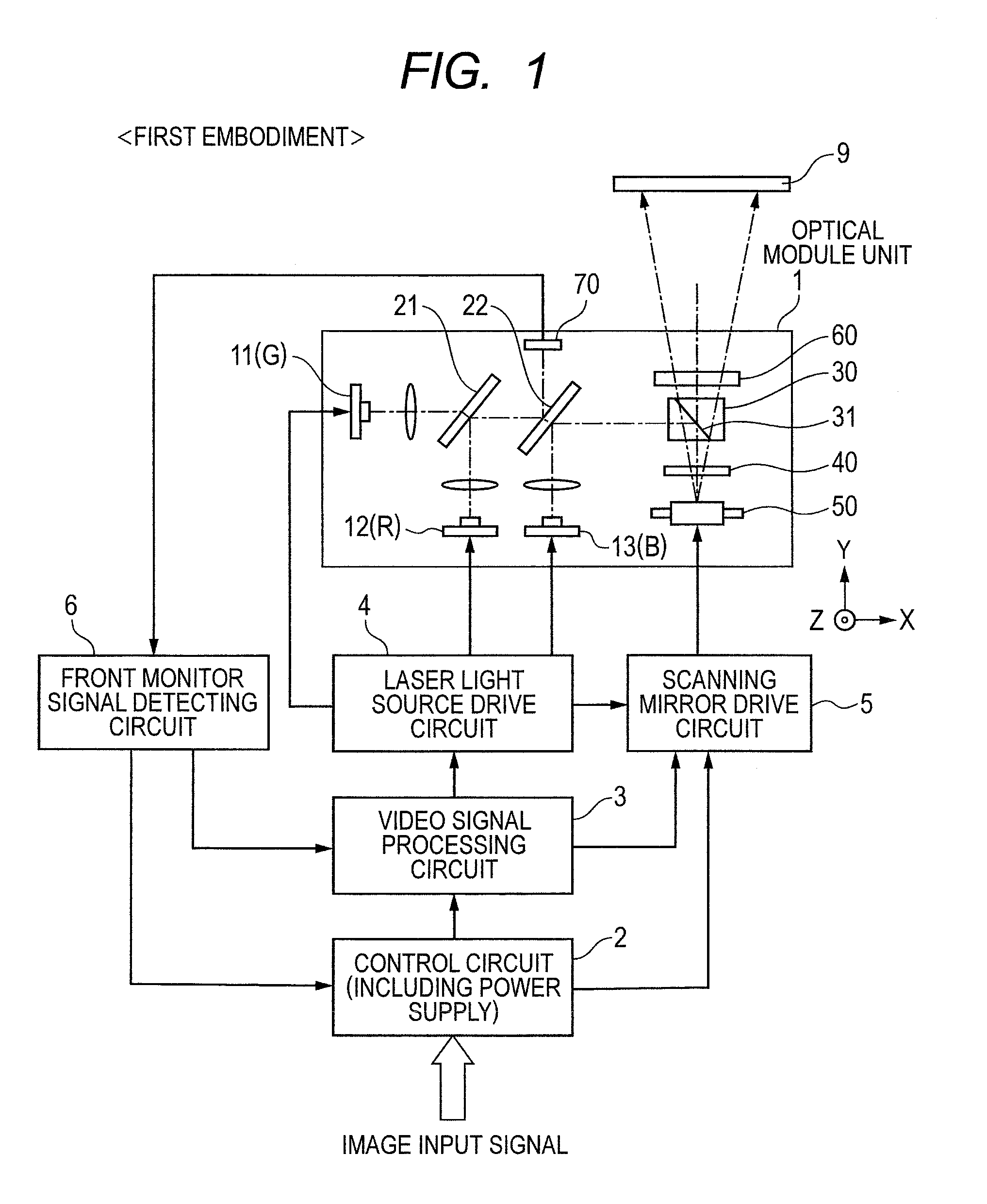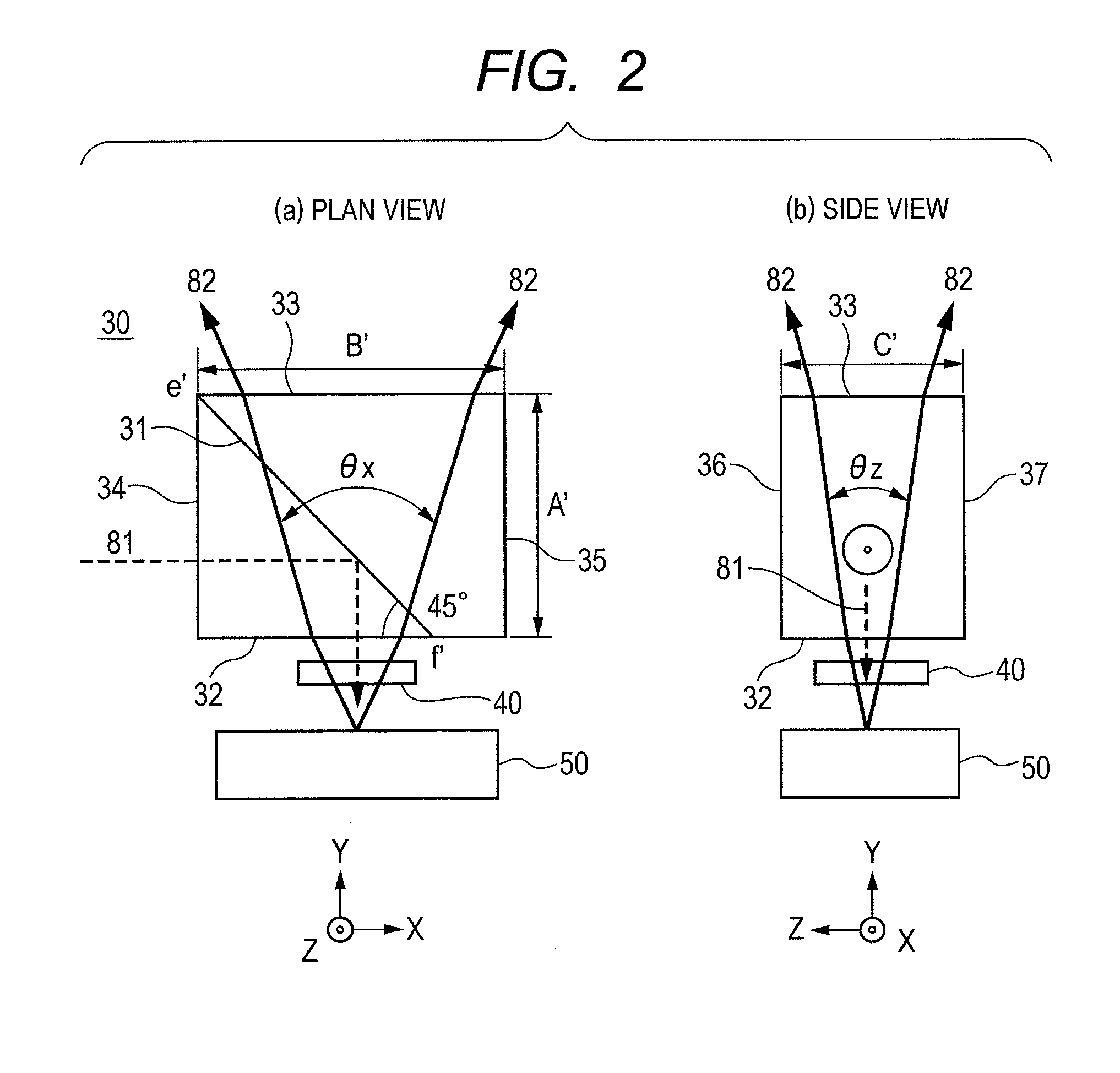Scan-type image display device and scan-type projection device
a projection device and scan-type technology, applied in the direction of instruments, polarising elements, optical elements, etc., can solve the problems of large image distortion, large size of entire casing, and increased parts cost, and achieve the effects of small size, simple configuration, and large siz
- Summary
- Abstract
- Description
- Claims
- Application Information
AI Technical Summary
Benefits of technology
Problems solved by technology
Method used
Image
Examples
first embodiment
[0034]FIG. 1 is an overall configuration diagram showing a first embodiment of a scan-type image display device according to the present invention. A one-dot chain line in the drawing indicates an optical axis of each light beam. An optical module unit 1 has laser light sources 11, 12 and 13 of three colors of green (G) / red (R) / blue (B), an optical combination unit which combines light beams emitted from the laser light sources, a projection unit which projects the combined light beam onto a screen 9, and a scanning unit which two-dimensionally scans the projected light beam on the screen 9. The optical combination unit includes wavelength selective mirrors 21 and 22, etc. The projection unit includes a polarizing prism (polarizing beam splitter) 30 including a PBS (Polarizing Beam Splitter) film 31, a ¼ wave plate 40, a speckle reduction element 60, etc. The scanning unit includes a scanning mirror (deflecting mirror) 50, etc.
[0035]An image signal to be displayed is inputted to a v...
second embodiment
[0051]FIG. 3 shows the form of a second embodiment of a polarizing prism 30, in which FIG. 3(a) is a plan view thereof and FIG. 3(b) is a side view thereof. The present embodiment is a structure in which the polarizing prism of the first embodiment (FIG. 2) is further eliminated in plane. In the plan view (a), the first side plane 34 and the second side plane 35 of the polarizing prism 30 are obliquely cut in the traveling direction of each light beams 82. That is, the XY sectional shape becomes trapezoidal, and the dimension (width) B″ of the incident plane 32 is set smaller than the dimension (width) B′ of the outgoing plane and reduced to B″=5.5 mm. The PBS film 31 is placed in a plane that connects an angle f′ of the incident plane 32 and an angle e′ of the outgoing plane 33. At the mention of the XY sectional shape, one end of the PBS film 31 and the other end thereof are laid out so as to intersect with the short and long sides at an angle of approximately 45° assuming that a ...
third embodiment
[0053]FIG. 4 shows the form of a third embodiment of a polarizing prism 30, in which FIG. 4(a) is a plan view thereof and FIG. 4(b) is a side view thereof. The present embodiment is a structure in which the polarizing prism of the second embodiment (FIG. 3) is further removed in plane. In the side view (b), the upper plane 36 and the lower plane 37 of the polarizing prism 30 are obliquely cut in the traveling direction of the light beams 82. Thus, the dimension (height) C″ of the incident plane 32 is set smaller than the dimension (height) C′ of the outgoing plane 33 and reduced to C″=5 mm. In the present embodiment, the upper and lower planes of the polarizing prism 30 are obliquely cut to make it possible to provide a size reduction in the polarizing prism on a three-dimensional basis. Even in the present embodiment, the direction of the optical axis on the laser light source side is corrected to prevent the optical path in the polarizing prism 30 from varying.
PUM
 Login to View More
Login to View More Abstract
Description
Claims
Application Information
 Login to View More
Login to View More - R&D
- Intellectual Property
- Life Sciences
- Materials
- Tech Scout
- Unparalleled Data Quality
- Higher Quality Content
- 60% Fewer Hallucinations
Browse by: Latest US Patents, China's latest patents, Technical Efficacy Thesaurus, Application Domain, Technology Topic, Popular Technical Reports.
© 2025 PatSnap. All rights reserved.Legal|Privacy policy|Modern Slavery Act Transparency Statement|Sitemap|About US| Contact US: help@patsnap.com



